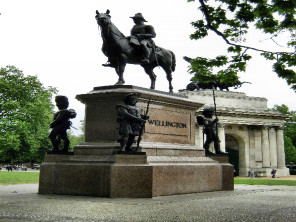
Evolution of the Island of Britain and the UK
1. Kings and Queens of Britain
2. Anglo Saxon Crown to Hastings 1066
3. Kings and Queens Hanover to Windsor
4. The Tower of London
5. Westminster The House of Parliament
6. Sir Winston Churchill
7. Winston Churchill Cabinet War Rooms WW2
8. Sir Winston Churchill Top Secret Cabinet War Rooms WW2
9. The Duke of Wellington
10. Duke of Wellington 1769-1852
11. Admiral Horatio Nelson
12. Life of Admiral Horatio Nelson
13. Life of Admiral Lord Horatio Nelson 1758-1805
14. Field Marshal Bernard Law Montgomery
15. HMS Victory
Arthur Wellesley
- The Duke of Wellington -
1769-1852
Arthur Wellesley the now Duke of Wellington was given command of a new allied army of British, Anglo-Netherlands and Prussian troops. Wellington was far from impressed by the quality of troops under his new command, much of the quality British troops were lost to the American War of Independence campaign and the Netherlands troops were either ex allies of the French or inexperienced in battle. But with typical stubbornness and very harsh, brutal discipline The Duke of Wellington forced his new command into an effective organisation gaining a vital victory against the French General Ney at the battle of Quatre Bras 16th June 1815 (which had severely worn down the experienced and hard to replace quantity of French troops available to Napoleon).
On 18 June 1815 The Duke of Wellington faced Napoleon Bonaparte at the Battle of Waterloo. Under Arthur Wellesly's command the allied force withstood attack after attack from the French army until the arrival of the Prussian reinforcements, forced the battle into The Duke of Wellington's favour. Napoleons Imperial Guard crumbled in a last desperate attempt to win back the initiative, and with the cream of Napoleons troops disorganised retreat, the French army itself disintegrated. It was to be The Duke of Wellington's greatest victory and as he noted 'A damn close-run thing'.
Arthur Wellesly returned to Britain a national hero while Napoleon Bonaparte was exiled for life on the remote island of St Helena. Returning to politics as his secondary career, his popularity propelled him to the position of Prime Minister 1828-1830. However he was not a successful leader of Government and he resigned office after two years mainly due to his opposition over voting reform (or indeed any reforms), his support for Catholic Emancipation 1829 and threat of Mob rioting against his leadership.
The Duke of Wellington later served under Sir Robert Peel (Prime Minister) as a minister of portfolio. In 1848 Arthur Wellesley again showed his contempt for the civilian population masses and as Commander in Chief of the British army arranged a military force to prevent any Chartist action within London.
The Duke of Wellington died in 1852, a few years before the Crimean War conflict 1854-1856, and was buried within St Paul's Cathedral.

Duke of Wellington 1769-1852

10